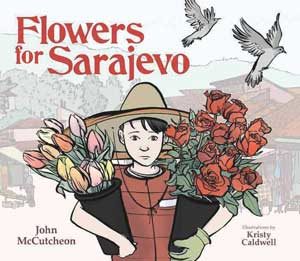Flowers for Sarajevo
Reviewed by Dave Austin
May 1, 2018
 By John McCutcheon, illustrated by Kristy Caldwell. Peachtree Publishers, 2017. 32 pages (plus audio CD). $19.95/hardcover and CD; $6.95/CD only. Recommended for ages 7–10.
By John McCutcheon, illustrated by Kristy Caldwell. Peachtree Publishers, 2017. 32 pages (plus audio CD). $19.95/hardcover and CD; $6.95/CD only. Recommended for ages 7–10.
Buy from QuakerBooks
First, I have a confession: there is no way I could review this book without a certain amount of bias. I have been a huge fan of John McCutcheon’s music for many years. His classic song “Christmas in the Trenches” has been a holiday staple in our family since I first heard it in 1984. And the book that resulted from that song is quite wonderful as well. So there was no way that I was going to pass on the chance to look at this latest book.
I was not disappointed. This is a marvelous book but a very different one from Christmas in the Trenches, because this is a very different story. Christmas in the Trenches was based on an incident that occurred on Christmas Eve 1914 on the Western Front. Flowers for Sarajevo is based on a story of an incident that occurred in the Bosnian War, when the nation formerly known as Yugoslavia fractured, and Serbian Christian and Croat Muslim neighbors turned against each other, resulting in some of the worse violence the world had seen since the end of World War II. The story is a fictional retelling of an incident that occurred on May 27, 1992, during the Siege of Sarajevo, when a mortar attack was launched against one of the last working bakeries in the city. This atrocity resulted in the deaths of many innocent people who were simply standing in line for bread.
McCutcheon tells the story through the eyes of a young boy named Drasko. For all of his young life, Drasko has sold flowers with his father from their stall in the Sarajevo marketplace. In spite of their differences—Serb and Croat, Christian and Muslim—all of the merchants have gotten along and worked side by side. But as Yugoslavia splinters and dissolves into civil war, the atmosphere changes and so do the attitudes of Drasko’s neighbors toward one another. Eventually, the war takes his father away, and Drasko must run their flower stand alone. But in spite of all these changes, there is at least one glimmer of what might be called hope in Drasko’s routine: the sound of the city’s orchestra as it practices each day in a rehearsal hall near the marketplace. Drasko can hear the music wafting from the walls and takes some comfort in it.
Then, even that peace is shattered. One morning as the church bells announce that it is ten o’clock, the city is mortared. Rockets target the bakery on the square where people have lined up for bread. Drasko runs with everyone else from the terrible scene. Twenty-two Sarajevans of all backgrounds are killed, and many more are injured.
The next day, the market square is empty and abandoned. Drasko waits for customers who do not come. The square is still empty when the church bells again chime ten o’clock. And at that moment, a mustachioed man in a tuxedo emerges from the rehearsal hall, carrying a chair and his cello. He walks down the sidewalk to the bomb crater in front of what had been the bakery. Once there, he sits and then begins to play. Those few who have ventured outside stop and listen in silence to the beautiful, heart-wrenching music. The cellist does this for 22 days, one day for each of those who died at the bakery that terrible morning. This is his prayer, his tribute, to the dead. It is his attempt to heal his broken land. It becomes Drasko’s prayer, too.
This tragic and beautiful story is told through McCutcheon’s simple and lyrical prose and Kristy Caldwell’s beautiful illustrations. The book also includes a brief history of the conflicts in the Balkans and resources for further reading and understanding. But what really pulls the book together is the CD, which includes a reading of the book by the author; a recording of McCutcheon’s song “Streets of Sarajevo” (accompanied by the cellist from the story, Vedran Smailović); a recording of Tomaso Albinoni’s “Adagio in G minor,” the composition that Smailović played on each of those 22 days; and a conversation with the author about the book project and the power of music to tell such stories.
In a time of conflict and fear, of division and “othering,” this is an important story from recent history. This book as well as McCutcheon’s earlier one should find a home in every meeting library and Friends school. Reading and listening to it together would make a wonderful intergenerational First-day school program or lesson in any classroom. It also serves to only further cement John McCutcheon’s place in the pantheon of great American folk music storytellers.



Comments on Friendsjournal.org may be used in the Forum of the print magazine and may be edited for length and clarity.